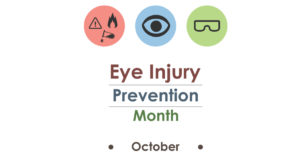
There’s No Place Like Home, Especially for Eye Injuries
Home may be where the heart is, but it can also be a dangerous place for the eyes. More than half of the 2.5 million eye injuries that occur every year happen within or around the home.
According to results from the “Annual Eye Injury Snapshot” by the American Academy of Ophthalmology (AAO) and the American Society of Ocular Trauma (ASOT), accidental eye injury is one of the leading causes of visual impairment in the United States, yet only 35 percent of Americans wear protective eyewear when doing projects that could threaten their vision.
Injuries can occur from a variety of sources including power tools, yard debris, cleaning fluids and chemicals. The research found that the most common place of injury was the yard or garden. In addition, one in four eye injuries that occurred in the home were due to home repair or use of power tools.
“Eye injuries in the home include everything from painful corneal abrasions, chemical splashes or punctures to the eye that can cause permanent vision loss,” says Dr. Marcy Hanudel with The Eye Clinic. “It’s easy to become complacent when doing everyday chores in the yard, home or garage. We realize that most people don’t even stop to think about eye protection for these routine tasks, but it’s important to be aware of the risk and protect your eyes. It’s estimated that 90 percent of eye injuries occurring in the home could be prevented by wearing appropriate protective eyewear. If you do get chemicals in the eye, irrigate immediately with the nearest source of clean water or balanced solution. Ex. Saline, artificial tears, etc. An eye injury can occur in a split second but have a lifelong impact on your vision.”
October has been designated “Home Eye Safety Awareness Month” by Prevent Blindness America in an effort to increase awareness of eye injury risk in the home, and to provide education about prevention.
The Eye Clinic offers these eye-safety tips:
- Wear eye protection when doing automotive work.
- Never mix cleaning agents. Read and follow all manufacturer instructions and warning labels and always use these products in well ventilated areas.
- Wear safety glasses with side protection or dust goggles when doing yard work to protect against flying particles, and chemical goggles to guard against exposure to fertilizers and pesticides.
- If you wear prescription glasses, many safety glasses or goggles will fit over your regular glasses. Regular eyeglasses do not always provide enough protection, and may even cause further injury upon impact.
- Inspect and remove debris from lawns before mowing. Make sure others in the yard are wearing eye protection as bystanders can be hit by flying debris.
- Keep tools in good condition; damaged tools should be repaired or replaced.
- After any project, make sure hands are washed thoroughly before touching the eyes or face.
- Seek medical care immediately for any eye injury.
For more information about protective eyewear, call Optics Unlimited at any location of The Eye Clinic or visit www.theeyeclinic.net.
